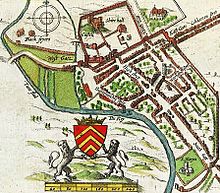
Cardiff Bay is an area and freshwater lake in Cardiff, Wales. The site of a former tidal bay and estuary, it is the river mouth of the River Taff and Ely. The body of water was converted into a 500-acre (2.0 km2) lake as part of a pre-devolution UK Government regeneration project, involving the damming of the rivers by the Cardiff Bay Barrage in 1999. The barrage impounds the rivers from the Severn Estuary, providing flood defence and the creation of a permanent non-tidal high water lake with limited access to the sea, serving as a core feature of the redevelopment of the area in the 1990s.

Cardiff city centre is the city centre and central business district of Cardiff, Wales. The area is tightly bound by the River Taff to the west, the Civic Centre to the north and railway lines and two railway stations – Central and Queen Street – to the south and east respectively. Cardiff became a city in 1905.
Huw Meredydd Stephens is a Welsh radio and television presenter, currently broadcasting on BBC Radio Wales, BBC Radio Cymru and BBC Radio 6 Music.

Clwb Ifor Bach is a Cardiff nightclub, music venue, Welsh-language club and community centre. It is known to the Cardiff Welsh-speaking community as Clwb and is often known by others on the Cardiff music scene as The Welsh Club.
Ifor Bach also known as Ifor ap Meurig and in anglicised form Ivor Bach, Lord of Senghenydd, was a twelfth-century resident in and a leader of the Welsh in south Wales.
Jarcrew was a five-piece dance-punk band from Ammanford, Wales. They were a relatively well known underground band for approximately five years between 2000 and their early 2005 split. They played a bizarre mixture of electronica/house and prog-rock/punk/funk that baffled audiences up and down the UK. Since disbanding, several Jarcrew off-shoots have emerged, most notably Future of the Left, a band that contained Jarcrew frontman Kelson alongside ex-mclusky members Andrew Falkous and Jack Egglestone. In 2014, the band reformed for a charity fundraiser and have since made a number of other appearances.

Tongwynlais is a village and community in the north of Cardiff, Wales, north of the M4 motorway in the Taff Valley. It is notable as the location of the hillside landmark, Castell Coch. The population as of the 2011 census was 1871.

The music of Cardiff has been dominated mainly by rock music since the early 1990s with later trends developing towards more extreme styles of the genre such as heavy metal and metalcore music. It, along with the nearby music scene in Newport, has brought a number of musicians to perform or begin their careers in South Wales.
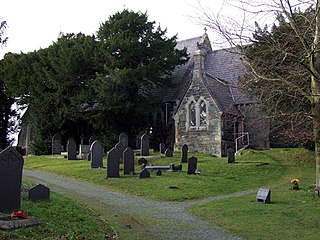
Tregarth is a village near Thomas Telford's A5 London to Holyhead road between the town of Bethesda and the city of Bangor in Gwynedd, north Wales. It is in Llandygai Community. It had a population of over 1,300 as of the 2011 census..

Sŵn Festival is a music festival founded by BBC Radio 1 DJ Huw Stephens and Cardiff-based promoter John Rostron. The festival takes place annually in Stephens' hometown of Cardiff, Wales. The first Sŵn Festival took place in November 2007. Bands playing included The Cribs, Beirut, David Holmes, Edwyn Collins and Cherry Ghost with DJs including Annie Mac.
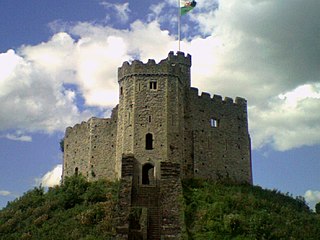
The history of Cardiff—a City and County Borough and the capital of Wales—spans at least 6,000 years. The area around Cardiff has been inhabited by modern humans since the Neolithic Period. Four Neolithic burial chambers stand within a radius of 10 mi (16 km) of Cardiff City Centre, with the St Lythans burial chamber the nearest, at about 4 mi (6.4 km) to the west. Bronze Age tumuli are at the summit of Garth Hill, within the county's northern boundary, and four Iron Age hillfort and enclosure sites have been identified within the City and County of Cardiff boundary, including Caerau Hillfort, an enclosed area of 5.1 ha. Until the Roman conquest of Britain, Cardiff was part of the territory of an Iron Age Celtic British tribe called the Silures, which included the areas that would become known as Brecknockshire, Monmouthshire and Glamorgan. The Roman fort established by the River Taff, which gave its name to the city—Caerdydd, earlier Caerdyf, from caer (fort) and Taf—was built over an extensive settlement that had been established by the Silures in the 50s AD.

Cardiff has many cultural sites varying from the historical Cardiff Castle and out of town Castell Coch to the more modern Wales Millennium Centre and Cardiff Bay. Cardiff was a finalist in the European Capital of Culture 2008.
The Barry Horns are an eleven-piece brass band, made up of fans of the Welsh national team. The band's name is a homage to retired Welsh footballer Barry Horne. The band has a five-point mission statement called the Barryfesto, which notes that the band exists in order
- to unite Welsh football with the power of horns
- to put tunes on the terraces
- to bring hope where there is mathematical impossibility
- to replace plastic hooters with brass ones
- to win at life when we can't win at football.
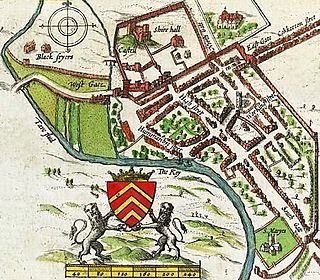
St Mary's Church was an Anglican church in Cardiff, Wales, which stood at the south end of the current St. Mary's Street, from 1107 until 1620. After severe flood damage it was abandoned in 1701 and later replaced at a different location in 1843.

The Old Library is a Grade II* listed building in Cardiff, Wales. It is located in the centre of the city at the northern end of The Hayes. Originally the Cardiff Free Library, it was used as the city's Central Library until it was replaced in 1988. It has been used for other purposes since that time and is currently the home of the Cardiff Story museum and the Royal Welsh College of Music and Drama.

Welsh Language Music Day is a music festival founded by radio presenter Huw Stephens. Events take place on the day at its base in Cardiff, as well as previously in London, Swansea, and even as far as Brooklyn and Budapest.
Gwilym (transl. William) are a Welsh-language pop rock group from Anglesey and Caernarfon. The band consists of members Ifan Pritchard, Llyr Jones, Llew Glyn, Rhys Grail, and Carwyn Williams. The group was founded in 2017.

Horizons is an arts scheme and music festival launched jointly in 2014 by BBC Cymru Wales and the Arts Council of Wales to develop new independent contemporary music artists. It is curated by BBC presenter Bethan Elfyn.
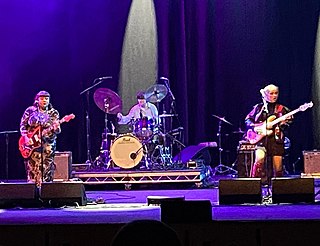
Adwaith (transl. Reaction) are a Welsh language indie rock group from Carmarthen in West Wales, formed in 2015. The group consists of Hollie Singer, Gwenllian Anthony and Heledd Owen (drums). Signed to Libertino Records, they released their first album Melyn in 2018. Both Melyn and its follow-up Bato Mato (2022) won Welsh Music Prize awarded for the best album from Wales, making Adwaith the first act to receive the award twice. A third album, Solas, is to be released in February 2025.

